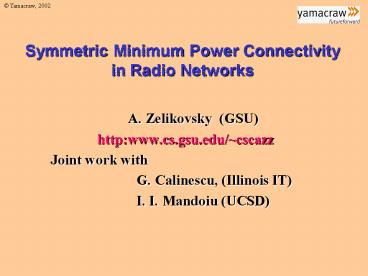Symmetric Minimum Power Connectivity in Radio Networks - PowerPoint PPT Presentation
1 / 12
Title:
Symmetric Minimum Power Connectivity in Radio Networks
Description:
http:www.cs.gsu.edu/~cscazz. Joint work with. G. Calinescu, ... Symmetric Minimum Power Problem in graphs is equivalent to Steiner Tree Problem in graphs ... – PowerPoint PPT presentation
Number of Views:47
Avg rating:3.0/5.0
Title: Symmetric Minimum Power Connectivity in Radio Networks
1
Symmetric Minimum Power Connectivity in Radio
Networks
- A. Zelikovsky (GSU)
- httpwww.cs.gsu.edu/cscazz
- Joint work with
- G. Calinescu, (Illinois
IT) - I. I. Mandoiu (UCSD)
2
Overview
- Connectivity in Radio Networks
- Symmetric Connectivity in Radio Networks
- Symmetric Minimum Power Problem (SPP)
- Graph Formulation of SPP
- Minimum Spanning Tree Algorithm
- Edge Swapping Heuristic
- Gain of Forks
- Greedy Algorithm
- Approximation Ratios
- Implementation Results
3
Connectivity in Radio Networks
1
1
1
1
3
1
Ranges
2
Nodes are 2-connected
1
1
1
1
3
1
Nodes transmit messages within a range depending
on their battery power. i.e., agb cgb,d
ggf,e,d,a
2
message from a to b has multi-hop
acknowledgement route.
Acknowledgement Problem
4
Symmetric Connectivity in Radio Networks
- Symmetric Connection ? 1 hop acknowledgement
- Two points are symmetrically connected
- ? they are in the range of each other
Asymmetric Connectivity
Symmetric Connectivity
1
1
1
1
1
1
1
1
3
1
1
2
2
2
Node a cannot get acknowledgement directly from
b
Increase range on b by 1 and decrease g by 2.
5
Symmetric Minimum Power Problem (SMPP)
- Range is proportional to the square root of power
- Power to connect (x1,y1 ) to (x2,y2) is ?
(x2-x1)2(y2-y1)2 - Symmetric Minimum Power Problem (SMPP)
- Given a set S of points in Euclidean plane
- Find assignments of powers to each point such
that - set S becomes symmetrically connected
- total power is minimized
powers
16
d
distances
To support connectivity tree we should assign
the total power of p(T) 257 The power
assigned to node should cover the longest
incident edge!
4
4
f
2
10
c
2
100
g
100
16
b
1
2
4
16
a
1
h
e
4
6
Graph Formulation of SMPP
- Power cost of a node is the maximum cost of the
incident edge - Power cost of a tree is the sum of power costs of
its nodes - Symmetric Minimum Power Problem in graphs
- Given a set of points in a graph G(V,E,c),
where c(e) is the power necessary to cover the
length of the edge e - Find a spanning tree in the graph with a minimum
power cost.
d
4
4
2
f
10
2
10
c
2
g
13
12
b
13
12
2
12
a
h
13
e
2
Power costs of nodes are blue Total cost of the
tree is 68
7
MST Algorithm
- Find the minimum spanning tree (MST) of G.
- Implement using Prims Algorithm
- Theorem The power cost of the MST is at most 2
OPT - Proof
- power cost of optimal spanning tree gt its cost
- power cost of a tree is at most twice its cost
- Worst- case example
n points
?
?
?
1
1
1
1 ?
1 ?
1 ?
Power cost of blue MST is n Power cost of red
OPT tree is n/2 (1 ?) n/2 ? ? n/2
8
Edge Swapping Heuristic
- For each edge do
- Delete an edge
- Connect with min increase in power-cost
- Undo previous steps if no gain
d
4
4
2
f
4
2
c
2
g
13
12
b
13
12
2
12
a
13
h
2
e
Remove edge 10 power cost decrease -6
4
d
4
f
2
2
4
c
2
g
13
12
b
13
15
15
2
12
15
a
h
2
e
Reconnect components with min increase in
power-cost 5
9
Gain of Forks
- A fork F is a pair of edges sharing an endpoint
- A gain of a fork w.r.t. a given tree T is the
decrease in power cost obtained by - adding fork edges F
- deleting two longest edges in two cycles of TF
8
d
2
8
f
13(3)
2
10
c
2
2(-10)
g
10
13
b
10
13
2
12
a
h
13 (3)
13 (1)
2
e
Fork with center a decreases the power-cost by
the gain 10-3-1-33
10
Greedy Algorithm
- Input Graph G(V,E,cost) with edge costs
- Output Low power-cost tree all vertices V
- TfMST(G)
- HfGRepeat forever
- Find fork F with maximum rgainT(F)
- If r is non-positive, exit loop
- HfH U F
- VfV/F
- Output Union of remaining MST and H
11
Approximation Ratios
- Symmetric Minimum Power Problem in graphs is
equivalent to Steiner Tree Problem in graphs - Theorem
- all forks have non-positive gain w.r.t. to a
tree T ? - power-cost (T) ? 5/3 OPT
- Theorem
- The approximation ratio of greedy algorithm
is at most 11/6 - Theorem
- There is an algorithm with approximation
ratio at most 1.64
12
Implementation Results
- For random instances up to 100 points
- The average loss in power cost of MST w.r.t. OPT
- 19
- The average improvement over the MST algorithm is
- 2 for greedy algorithm
- 6.5 for edge swapping heuristic
- 8 for edge swapping heuristic followed by greedy































